Financial Statements: Pension Plans
Tan KW
Publish date: Sun, 14 Jul 2013, 07:32 PM
By David Harper
(Contact David)
Following from the preceding section focusing on long-term liabilities, this section focuses on a special long-term liability, the pension fund. For many companies, this is a very large liability and, for the most part, it is not captured on the balance sheet. We could say that pensions are a type of off-balance-sheet financing. Pension fund accounting is complicated and the footnotes are often torturous in length, but the good news is that you need to understand only a few basics in order to know the most important questions to ask about a company with a large pension fund.
There are various sorts of pension plans, but here we review only a certain type: the defined benefit pension plan. With a defined benefit plan, an employee knows the terms of the benefit that he or she will receive upon retirement. The company is responsible for investing in a fund in order to meet its obligations to the employee, so the company bears the investment risk. On the other hand, in adefined contribution plan, a 401(k), for example, the company probably makes contributions or matching contributions, but does not promise the future benefit to the employee. As such, the employee bears the investment risk.
Among defined benefit plans, the most popular type bears a promise to pay retirees based on two factors: 1) the length of their service and 2) their salary history at the time of retirement. This is called a career average or final pay pension plan. Such a plan might pay retirees, say, 1.5% of their "final pay," their average pay during the last five years of employment, for each year of service for a maximum number of years. Under this plan, an employee with 20 years of service would receive a retirement benefit equal to 30% (20 years x 1.5%) of their final average pay. But formulas and provisions vary widely; for example, some will reduce or offset the benefit by the amount of social security the retiree receives.
Funded Status = Plan Assets - Projected Benefit Obligation (PBO)
A pension plan has two primary elements:
- The future liabilities, or benefit obligations, created by employee service.
- The pension fund, or plan assets,that are used to pay for retiree benefits.
Three things make pension fund accounting complicated. First, the benefit obligation is a series of payments that must be made to retirees far into the future. Actuaries do their best to make estimates about the retiree population, salary increases and other factors in order to discount the future stream of estimated payments into a single present value. This first complication is unavoidable.
Second, the application of accrual accounting means that actual cash flows are not counted each year. Rather, the computation of the annual pension expense is based on rules that attempt to capture changing assumptions about the future.
Third, the rules require companies to smooth the year-to-year fluctuations in investment returns and actuarial assumptions so that pension fund accounts are not dramatically over- (or under-) stated when their investments produce a single year of above- (or below-) average performance. Although well-intentioned, smoothing makes it even harder for us to see the true economic position of a pension fund at any given point in time.
Let's take a closer look at the two basic elements of a pension fund:
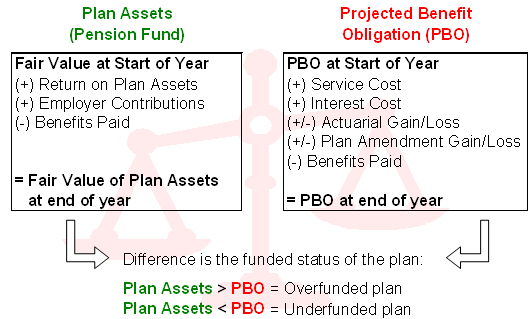 |
On the left, we show the fair value of the plan assets. This is the investment fund. During the year, wise investments will hopefully increase the size of the fund. This is the return on plan assets. Also, employer contributions, cash the company simply gives from its own bank account, will increase the fund. Finally, benefits paid (or disbursements) to current retirees will reduce the plan assets.
On the right, we show the basic calculation of the projected benefit obligation (PBO), which is an estimate of the future stream of benefit obligations discounted to the present value into a single number. For clarity's sake, we omitted a few items.
In the annual report, you will see two other measures of estimated future obligations: the vested benefit obligation (VBO) and the accumulated benefit obligation (ABO). You do not need either of these for the purposes we discuss here, but ABO is less than PBO because it assumes that salaries will not rise into the future, while PBO assumes salary increases. VBO is less than ABO because it counts only service already performed, but PBO counts the future service (minus turnover assumptions). PBO is the number that matters because it's the best guess as to the present value of the discounted liabilities assuming the employees keep working and salaries keep rising.
By subtracting the PBO from the fair value of the plan assets, you get the funded status of the plan. This is an important number that will be buried somewhere in the footnotes, but it must be disclosed.
Breaking Down the Funded Status of the Plan
Let's look at an actual example. We will use data from the annual report 10-K for PepsiCo (ticker: PEP) for the year ended Dec 31, 2003. Although its pension plan happened to be under-funded at that time, it can be considered relatively healthy, especially compared to other companies. We picked PepsiCo because the company's plan is well-disclosed and its 10-K contains helpful commentary.
Below is the part of the footnote that calculates the fair value of the plan assets. You can see that the pension fund produced an actual return of 7.9% in the year 2003 ($281 / $3,537). Other than the investment returns, the largest changes are due to employer contributions and benefit payouts:
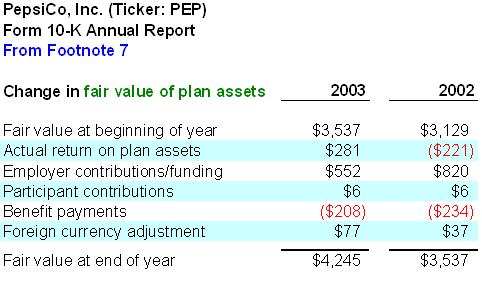 |
Now take a look at the calculation of the PBO (see below). Whereas the fair value of plan assets (how much the fund was worth) is a somewhat objective measure, the PBO requires several assumptions which make it more subjective:
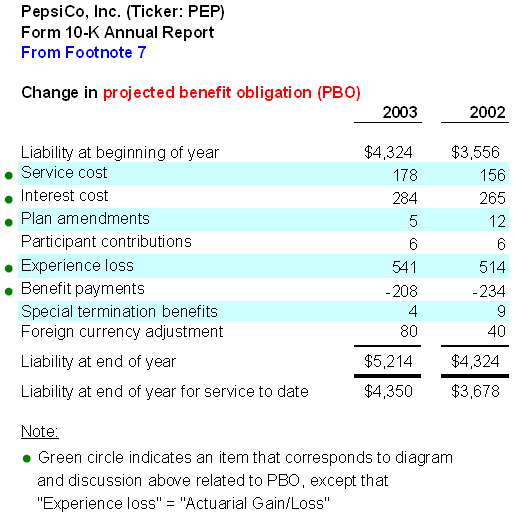 |
You can see that PepsiCo started 2003 with an estimated liability of $4,324, but the liability is increased by service and interest cost. Service cost is the additional liability created because another year has elapsed, for which all current employees get another year's credit for their service. Interest cost is the additional liability created because these employees are one year nearer to their benefit payouts.
The reason for and effect of the additional interest cost is easier to understand with an example. Let's assume that today is 2005 and the company owes $100 in five years, the year 2010. If the discount rate is 10%, then the present value of this obligation is $62 ($100 ÷ 1.1^5 = $62). (For a review of this calculation, see Understanding the Time Value of Money.) Now let one year elapse. At the start of 2006 the funds now have four years instead of five years to earn interest before 2010, the present value of the obligation as of 2006 increases to $68.3 ($100 ÷ 1.1^4 = $68.3). You can see how interest cost depends on the discount rate assumption.
Now, let's continue with PepsiCo's footnote above. Plan amendments refer to changes to the pension plan and they could have a positive or negative impact on cost. Experience loss is more commonly labeled actuarial loss/gain, and it too can be positive or negative. It refers to additional costs created because the changes in actuarial estimates changes made during the year. For example, we don't know the cause in PepsiCo's case, but perhaps it increased its estimate of the average rate of future salary increases or the average age of retirement. Either of these changes would increase the PBO and the additional cost would show up as an actuarial loss.
We see that PepsiCo's liability at the end of the year 2003 was $5,214. That is the PBO. We also see a lesser amount "for service to date." That is the VBO and we can ignore it.
The fair value of the plan assets ($4,245) subtracted by the PBO ($5,214) results in the funded status at the end of 2003 of -$969 million. The bottom line: PespiCo's pension plan at that time was under-funded by almost one billion dollars.
Pension Plans and the Balance Sheet
Now remember we said that pension plans are off-balance-sheet financing, and in PepsiCo's case, the $4.245 billion in assets and $5.214 billion in liabilities are not recognized on the balance sheet. Therefore, typical debt ratios like long-term debt to equity probably do not count the pension liability of $5+ billion. But it's even worse than that. You might think the net deficit of -$969 million would be carried as a liability, but it is not. Again, from the footnotes:
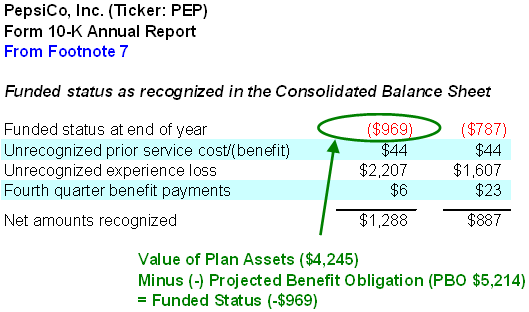 |
Due to the smoothing rules of pension plan accounting, PepsiCo carried $1,288 in pension plan assets on the balance sheet, at the end of 2003. You can see how the two "unrecognized" lines on the footnote above boost the negative into a positive: the losses for the current year, and prior years, for that matter, are not recognized in full; they are amortized or deferred into the future. Although the current position is negative almost one billion, smoothing captures only part of the loss in the current year--it's not hard to see why smoothing is controversial.
Cash Contributed to the Pension Is Not Pension Cost
Now we have enough understanding to take a look at why cash contributed to the pension plan bears little, if any, resemblance to the pension expense (also known as "pension cost") that is reported on the income statement and reduces reported earnings. We can find actual cash contributed in the statement of cash flows:
 |
Now compare these cash contributions to the pension expense. In each of the three years reported, cash spent was significantly higher than pension expense:
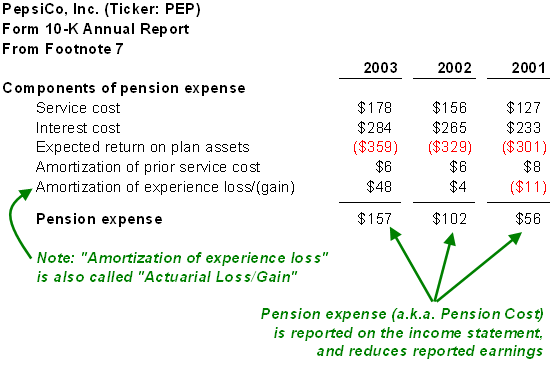 |
The first two components of pension expense - service and interest cost - are identical to those found in the calculation of PBO. The next component is "expected return on plan assets." Recall that the "fair value of plan assets" includes actual return on plan assets. Expected return on plan assets is similar, except the company gets to substitute an estimate of the future return on plan assets. It is important to keep in mind that this estimate is an assumption the company can tweak to change the pension expense. Finally, the two "amortization" items are again due to the effects of smoothing. Some people have gone so far as to say the pension expense is a bogus number due to the assumptions and smoothing.
Critical Questions
We have just scratched the surface of pension plan accounting, but we have reviewed enough to identify the four or five critical questions you need to ask when evaluating a company's pension fund.
We have two primary concerns in regard to analysis of the pension fund:
- What is the economic status of the liability? A dramatically under-funded plan will require increased cash contributions in the future and foreshadows future increases in income statement expenses.
- How aggressive/conservative is the pension expense? An aggressive accounting policy is a red flag because it will usually have to be unraveled by the company in future periods. Conservative policies contribute to earnings that are higher in quality.
Take a look at key assumptions disclosed by PepsiCo:
 |
In regard to our first concern - the economic status of the liability - we want to look at the funded status that equals the fair value of plan assets minus the PBO. The two key assumptions that impact the PBO are the discount rate and projected rate of salary increases. A company can decrease its PBO (and therefore, increase its funded status) by either increasing the discount rate or lowering the projected rate of salary increases. You can see that PepsiCo's rate of salary increase is fairly stable at 4.4% but the discount rate dropped to 6.1%. This steady drop in the discount rate contributes significantly to the increased PBO and the resultant under-funded status.
 |
In regard to our second concern - the quality of the pension expense - there are three key assumptions:
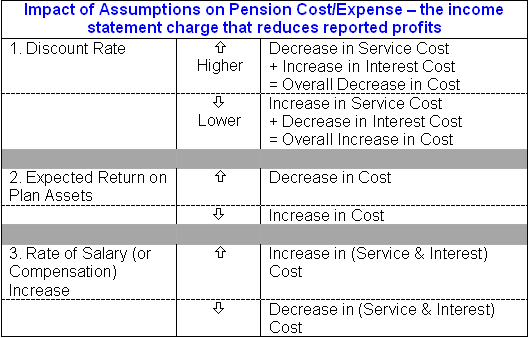 |
So we can now summarize the effect of accounting practices:
- Aggressive (dubious) accounting includes one or more of the following: a high discount rate, an expected return on plan assets that is overly optimistic by being quite higher than the discount rate and a low rate of salary increase.
- Conservative (good) accounting includes all of the following: low discount rate, an expected return on plan assets that is near the discount rate and a high rate of salary increase
You should definitely look at these allocations if you have a view about the equity or bond markets. There has been much academic discussion about companies' allocation mismatching. The argument goes that they are funding liabilities with too much equity when liabilities should be funded with bonds. Of course, companies fund with equities to boost their actual and expected returns.
Conclusion
For evaluating stocks that have a pension plan, you can do the following:
|
1. Locate the funded status, or the fair value of plan assets minus projected benefit obligation. 2. Check the trend and level of the following key assumptions:
3. Check the target and actual allocation of the pension plan. Is the company making sufficient use of bonds to fund the pension liability and, conversely, are they overly exposed to equities? |
http://www.investopedia.com/university/financialstatements/financialstatements9.asp





















